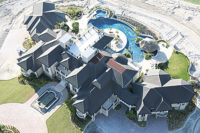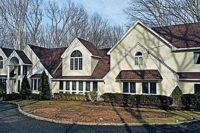
When members of the International Buddhist Progress Society set out to build a new worship center in Houston, they wanted a roof that would satisfy special aesthetic requirements and local environmental concerns, while at the same time staying within budget constraints. Meeting this challenge would require the right contractor and the right system.
The Contractor
Metals Specialties, Houston, is an architectural sheet metal company that got its start in 1984 — working for a canvas awning company. Metal Specialties made the metal frames and did the installation. “Sometimes we got inquiries for different types of awnings,” says Anthony Vento, president. “I started doing research and saw that there was a demand for metal outside of awnings and canopies. Metal roofing was becoming more used and accepted. We got into the business and it evolved over a period of time.”Toward the end of the 80s, the company stopped working for the awning companies. It now does metal roofing, facades, soffits and other projects requiring metal – everything but metal buildings. The company’s focus is commercial, although sometimes it will be sought out for an upscale residential job.
Vento sees the metal roofing business continuing to grow, albeit slower than before. “There has been a slight amount of growth over the last three to five years. The five years prior to that saw more growth,” he says. “I don’t know if that’s our business or the market in general. We try to stay within a 50-mile radius of Houston.” Schools make up the biggest part of Metal Specialties’ business, while all types of retrofit show good growth.
At the time of this interview, Metal Specialties hadn’t noticed much of an economic slowdown, though Vento mentions that labor is a constant problem. “We are stretched thin and have to work overtime; I don’t think we’ve found a solution. We are constantly hiring people, looking for people to hire, getting the word out, training and retraining. It’s never ending, even during good times.” Vento says Metal Specialties hires weekly and there is a lot of turnover. “It’s just the nature of the business,” he explains. “Roofing is very hard work in Houston in the summer.”
The Project
But Metal Specialties can do the hard work, and its experience and previous history with Mission Construction, Houston, brought an opportunity to build the roof on a new Buddhist Temple.The worship center is the first building in a 10-year expansion project known as the Fo Guang Shan Chung Mei Temple. “Over the next several years, there will be many phases of construction to complete the facility,” states Reverend Hong of the International Buddhist Progress Society of Houston. “When completed, there will be more than 10 buildings over 32 acres — including the Main Shrine, Pilgrim lodge, auditorium, exhibit hall, meditation rooms, classrooms and more.”
When the Main Shrine is built, she notes that the current worship center will actually become a dining hall. “We are pleased with how the building team has been able to combine Eastern traditions with Western materials and environmental concerns,” says Reverend Hong. The completed facility will serve four objectives: To propagate Buddhist teachings through cultural activities, to foster talent through education, to benefit society through charitable programs, and to purify human hearts and minds through Buddhist practice.
The System
To meet the temple’s specific requirements, the Houston-based architectural firm of Tackett Lodholz specified a metal “tile panel” roof manufactured by Met-Tile Inc., Ontario, Calif. Gerald Tackett, principal of the firm, explains: “Glazed ceramic tile is generally the roof of choice on Buddhist Temples, in a yellow-bronze Holy color that has been used for more than 3,000 years. But imported tile would have been prohibitively expensive in Houston, and its heavy weight would have required extra structural support. By substituting a lighter-weight metal panel system in place of tile, we overcame cost and weight concerns.”
To achieve the desired aesthetics, Tackett worked with the manufacturer and its local representative, Paul Gavranovic, on special color and finish requirements. First, they obtained ceramic tile samples from an affiliated temple in Los Angeles. The paint finish manufacturer, Dura Coat Products Inc., Riverside, Calif., then created a special color called “E.S. Mustard” that was virtually a perfect match for the ancient Holy color, producing it in a high-gloss finish that further mimicked the look of glazed tile.
The Roof
According to Russell Deaton, superintendent and 18-year veteran of Metal Specialties, the detail-oriented job “took forever” to complete – about nine weeks. The crew of six had worked with Met Tile before, but had to learn new detail work for this job. “We used their book,” Deaton explains. “It covers every type of installation.” He describes the job as “trim intensive” — there was specialty trim on the soffits, fascia, ridges and gables.The roof itself consists of 3-foot-wide, 26-gauge steel panels in varying lengths up to 22 feet. Once installed, these large metal panels look remarkably like tile.
“In designing the roof, we tried to retain a traditional look while also accommodating local conditions,” adds Tackett. “For example, we extended the overhang around the building for protection from the heavy rains that are common here.”
More than 31,000 square feet of material were needed to roof the new Buddhist worship center. The metal panels install vertically and are secured with screw fasteners, creating a highly weather-tight covering.
Aside from the custom color and finish requirements, the roof design created additional challenges for everyone on the job. To begin with, the panels were manufactured in 12 different lengths to accommodate a complex design with changing angles (there are three slope changes on a single side of the roof). In addition, Metal Specialties fabricated special barrel-shaped ridge pieces onsite. They were used to create a look that more closely resembled Asian tile systems. Workers also installed clay figurines, which were imported from Taiwan, at the top and corners of the roof. Crews embedded dowels into the figures and caulked around them after installation. Produced in the same color as the roof panels, these animal and human figures symbolize guardians protecting the Temple.




